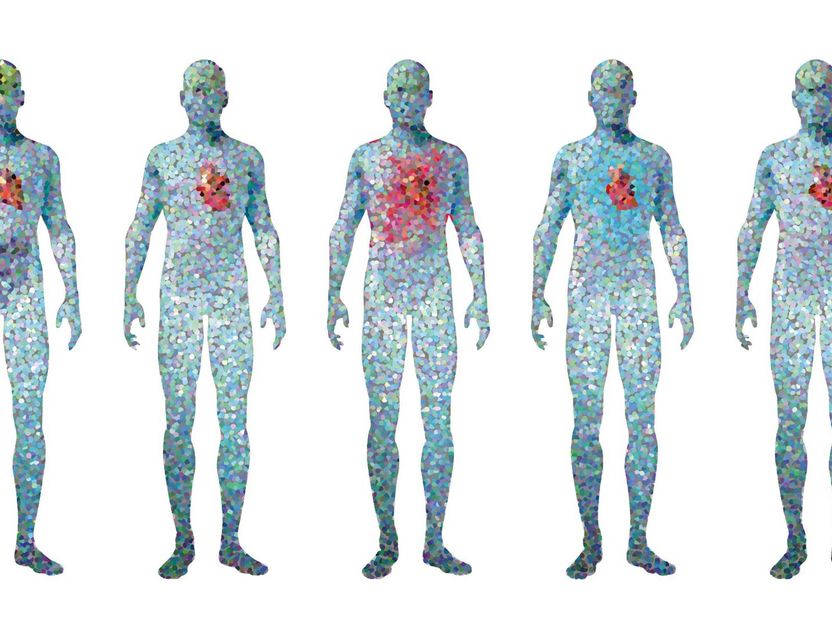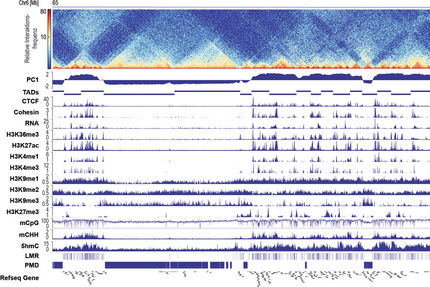Call for standards of epigenetic data
At the heart of every cell is the nucleus, which acts as the cell’s control center. Recent studies have revealed more and more information about its organization and dynamics. However, the rapid development of methods and the increasing complexity of the collected data pose major challenges. Leading scientists in the field have therefore called for uniform standards of epigenetic data. Among them is Maria Elena Torres-Padilla of Helmholtz Zentrum München.

Spencer Phillips/EMBL-EBI
The nucleus contains all the information needed for survival of the cell and the organism in the form of the genetic information - the DNA. The DNA is intricately packaged in order to fit all the information into the cell nucleus and to make the genes accessible at the right time. “We are currently endeavoring to understand the organizational levels and to find out how they change over time, for example in the course of development or during the emergence of diseases,” explains Prof. Dr. Maria Elena Torres-Padilla, Director of the Institute of Epigenetics and Stem Cells (IES) at Helmholtz Zentrum München. She is an expert in epigenetics, which studies, amongst other things, how our genes respond to the environment.
She and her international colleagues are making good progress, for example in the context of the 4D Nucleome network. “The aim is to create a kind of atlas for all the different types of cells that captures the three-dimensional organization of the nucleus and documents how it changes over time, thus 4D for the fourth dimension,” Torres-Padilla explains. In this way, she and her colleagues hope to discover fundamental mechanisms underlying the fate of cells and in the long term to find out how a single cell develops into a fully-fledged organism.
Opportunities and challenges of new technologies
However, new technologies and mushrooming data volumes are creating new challenges along this path. “As exciting and promising as current developments are, we now see a good opportunity to unite our efforts. We, as 4D Nucleome members, are therefore proposing measures to establish uniform standards. This applies both to the technologies used and to the documentation of the results and how they are shared with the international research community.” In this way, the scientists want to ensure that information is integrated and resources are used efficiently.
The 4D Nucleome Network is a main pillar of the LifeTime Initiative, which was set up in 2018 and is also supported by the Helmholtz Association. As part of this project, experts from science and industry aim to reliably predict, when a disease is likely to become manifest and what course it is likely to take. The founding members include IES Director Professor Maria Elena Torres-Padilla and Professor Fabian Theis, Director of the Institute of Computational Biology at Helmholtz Zentrum München.
“Through the LifeTime initiative and collaborations with industrial partners, our results will have even great impact,” says Torres-Padilla. “Our overall aim to provide the information through which physicians may give earlier diagnosis and treatment regimens according to the molecular state of a patient’s tissues is incredibly important, and exciting. This is a 10 year game-changing vision, which will be enabled through the participation of many stakeholders and includes large aspects of both basic and applied research across Europe, as well as key strategic collaborations with our industrial partners.”
Original publication
Marc A. Marti-Renom, Genevieve Almouzni, Wendy A. Bickmore, Kerstin Bystricky, Giacomo Cavalli, Peter Fraser, Susan M. Gasser, Luca Giorgetti, Edith Heard, Mario Nicodemi, Marcelo Nollmann, Modesto Orozco, Ana Pombo & Maria-Elena Torres-Padilla; "Challenges and guidelines toward 4D nucleome data and model standards"; Nature Genetics; 2018
Most read news
Original publication
Marc A. Marti-Renom, Genevieve Almouzni, Wendy A. Bickmore, Kerstin Bystricky, Giacomo Cavalli, Peter Fraser, Susan M. Gasser, Luca Giorgetti, Edith Heard, Mario Nicodemi, Marcelo Nollmann, Modesto Orozco, Ana Pombo & Maria-Elena Torres-Padilla; "Challenges and guidelines toward 4D nucleome data and model standards"; Nature Genetics; 2018
Organizations
Other news from the department science

Get the life science industry in your inbox
By submitting this form you agree that LUMITOS AG will send you the newsletter(s) selected above by email. Your data will not be passed on to third parties. Your data will be stored and processed in accordance with our data protection regulations. LUMITOS may contact you by email for the purpose of advertising or market and opinion surveys. You can revoke your consent at any time without giving reasons to LUMITOS AG, Ernst-Augustin-Str. 2, 12489 Berlin, Germany or by e-mail at revoke@lumitos.com with effect for the future. In addition, each email contains a link to unsubscribe from the corresponding newsletter.




















































